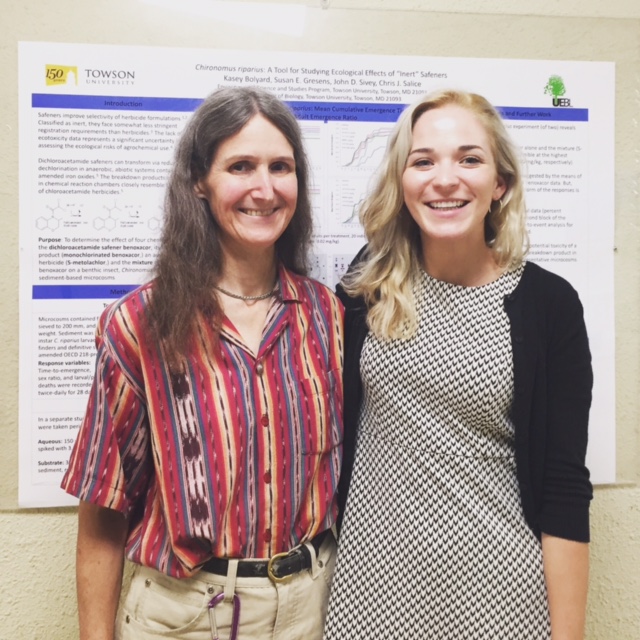Research spotlight on…Susan Gresens
TU professor-student collaboration investigated what happens if herbicides containing safeners run off into Maryland’s freshwater resources and end up in the Chesapeake Bay
By Megan Bradshaw on October 31, 2016
How safe are safeners?
Safeners are chemicals added to some herbicides to protect crops from the herbicides themselves. They are an inert ingredient in herbicides, so they are not subjected to the level of regulatory scrutiny active ingredients receive when it comes to their environmental effects.
So what happens if herbicides containing safeners run off into Maryland’s freshwater resources and end up in the Chesapeake Bay? What effect could that have on a fragile ecosystem that supports many state industries?

Towson University Jess and Mildred Fisher College of Science and Mathematics biology professor Susan Gresens oversaw a collaborative research project between her master’s student Kasey Bolyard, assistant professor of chemistry John Sivey and Chris Salice, director of TU’s environmental science and studies program, in examining that question. Bolyard studied the toxicity of the safener benoxacor in comparison with its herbicide partner, a mixture of the two chemicals, and a break-down product of benoxacor.
Sivey’s lab discovered that under oxygen-free conditions this safener breaks down into a compound that closely resembles the herbicide partner, suggesting persistent toxicity. Salice shared his expertise in analysis of ecotoxicology experiments. The Maryland Water Resources Research Center also awarded Bolyard a summer fellowship that allowed her to carry out this project.
Bolyard’s research featured two novel aspects: the paucity of data on safener toxicity and the use of laboratory microcosms with “custom” sediment and a benthic (bottom-dwelling) aquatic insect, Chironomus riparius, that mimicked natural conditions.
Sivey’s research suggested that as the safener washes off cornfields and into stream sediments and groundwater, it would break down into a still-toxic compound if it was in an anaerobic, oxygen-free habitat with plenty of iron, which is also where Chironomus larvae like to burrow.
Bolyard made two presentations on her research at national meetings. In short, she found that all four chemical treatments had significant toxic effects on the survival, growth and development of C. riparius. While the chemical concentrations at which this was observed were higher than what has been measured (for the herbicide at least) in natural surface and groundwaters, it is a wake-up call to monitor the amount of safeners as well as herbicides in freshwater runoff that ultimately enters reservoirs and drinking water wells.